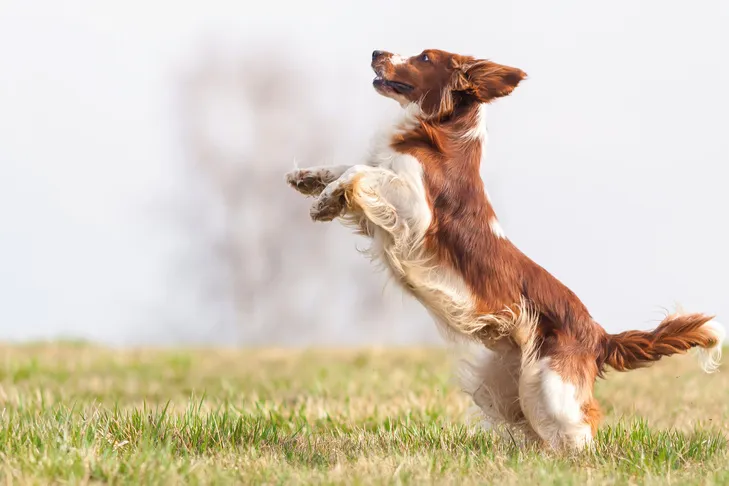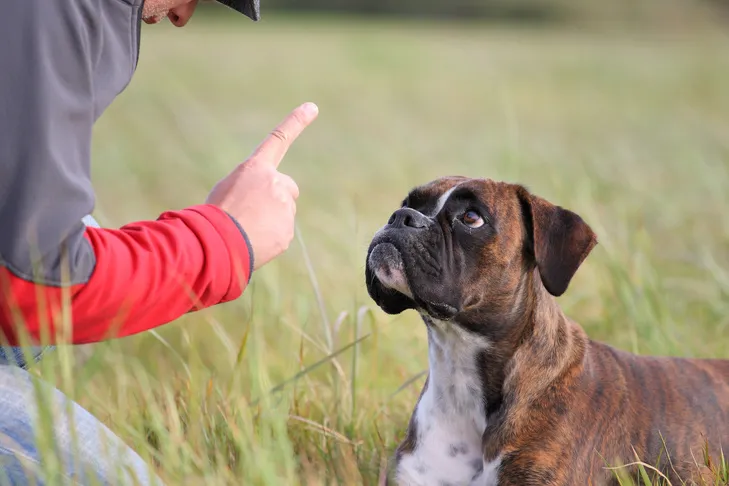Greeting people with enthusiastic jumps is a common behavior for many dogs. While often stemming from pure joy and excitement, this can quickly become an annoying habit, and for larger breeds, it can even be dangerous, potentially knocking over children or seniors. Even smaller dogs can leave muddy paw prints or cause scratches. Fundamentally, your dog is simply trying to say “hello” face-to-face and has learned that jumping is an effective way to get your attention. So, how can you effectively teach your dog to stop jumping when it feels so natural for them? The key is to teach your dog an alternative, more polite greeting rule, such as keeping their front paws on the floor. This provides a safer and more courteous way for your pet to welcome you home and earn the attention they crave. Mastering proper leash control from a young age can also prevent over-excitement in greetings, making it easier to manage their behavior. how to leash train a lab puppy
These ten effective tips will guide you in teaching your dog appropriate greeting behaviors, ensuring they know exactly how to say “hi” to humans in a well-mannered way.
1. Only Greet Your Dog When They Have Four Paws on the Floor
The most effective approach to addressing unwanted behavior is to teach an incompatible alternative. Dogs learn more quickly and easily when you show them what to do, rather than just what not to do. In the context of jumping, this means training your dog to keep all four paws firmly on the floor. They cannot jump and stand simultaneously. Alternatively, you might prefer them to sit or lie down for greetings. Whatever rule you establish, consistently provide attention and greet your dog only when they are following this rule. Consistency is paramount; avoid situations where jumping is sometimes tolerated (e.g., when you’re in casual clothes) and sometimes not.
2. Give Attention As Soon As Your Dog’s Front Feet Hit the Floor
Dogs are more likely to repeat behaviors that yield desirable outcomes. Therefore, as long as your dog adheres to your greeting rule, such as keeping all four feet on the floor, immediately reward them with praise and petting. Your dog’s primary motivation is your attention, so ensure they receive it the moment they do the right thing, especially during the learning phase. Avoid delaying your greeting by, for instance, removing your coat and shoes first. Such delays can lead to impatience, prompting your dog to try jumping again to capture your notice.
3. Remove Attention When Your Dog Jumps
Conversely, the only way to eliminate jumping is to stop reinforcing it. Never reward a behavior you wish to extinguish. If your dog jumps on you, promptly withdraw what they seek – your attention. This could involve calmly turning your back or walking away, signaling to your dog that jumping produces the opposite effect of what they intended. However, as soon as your dog returns to all four paws on the floor, turn back and quietly praise and pet them. This consistent on-off signal will help your dog understand that their jumping behavior controls whether they receive your attention.
 Welsh Springer Spaniel jumping up outdoors.
Welsh Springer Spaniel jumping up outdoors.
4. Set Up Your Dog for Success
While ignoring jumping and rewarding proper greetings is effective, it can be a slow, trial-and-error process for your dog. You can expedite their learning by setting them up for success, making it easier for them to comply with your greeting rule. If your rule is to sit for greetings, proactively ask them to sit the moment you enter. If you require four paws on the floor, encourage them to remain standing.
A clever tactic to prevent jumping is to scatter small treats on the floor. Most dogs find free goodies irresistible, and they cannot jump while simultaneously sniffing and consuming treats from the ground. You need to be quick, but if you provide the food before your dog even considers jumping, you can reward their “four on the floor” behavior with both attention and treats. Your dog will rapidly grasp the greeting rule, allowing you to gradually phase out the food rewards over time. This foundational training builds on the principles of basic obedience. teaching your puppy how to walk on a leash
5. Always Reward Your Dog for Proper Greeting Behavior
Your dog will learn appropriate greeting behavior much faster if their actions have an immediate and clear impact on your attention – four paws on the floor earns attention, while jumping makes it disappear. This means you must consistently reward your dog every single time they follow your greeting rule. Even if you’re feeling frustrated after several minutes of jumping, never withhold your attention when your dog finally settles with all four feet on the floor. Inconsistency will confuse your dog and undermine the training process.
6. Don’t Grab or Push Your Dog Away
It’s crucial to remember that your dog jumps primarily to gain your attention. Any physical interaction, even a seemingly negative one like grabbing your dog, holding their paws, or pushing them away, is still a form of attention. This inadvertently rewards the jumping behavior and can, in the long run, increase its frequency rather than reduce it. Furthermore, for many dogs, such physical contact can be misinterpreted as an invitation for roughhouse play. They might return with even more vigorous jumps, believing it’s all part of an exciting game.
 American Hairless Terrier jumping up on the leg of its owner outdoors.
American Hairless Terrier jumping up on the leg of its owner outdoors.
7. Don’t Put Your Knee Up When Your Dog Jumps
A common piece of advice you might encounter is to raise your knee to block your dog’s chest when they jump. However, as discussed, this action can be misconstrued as attention or a wrestling game by some dogs, potentially exacerbating the jumping behavior. More importantly, for the majority of dogs, this physical deterrent can erode trust and damage the human-canine bond. Your dog is merely attempting to say “hello,” and being met with a knee can feel like a punishment. It could even cause injury. A breakdown in trust can lead to other behavioral issues, such as a reluctance to teach your dog to come when you call or general disobedience.
8. Keep Greetings Low-Key While Your Dog Is Learning
Dogs often struggle to control their excitement when greeting their beloved humans. It requires significant emotional self-control for them to suppress the natural urge to jump and instead adhere to a new greeting rule. You can make this easier for your dog by keeping your own greetings low-key. Dogs are highly perceptive and can read our emotions; if you are overly excited, they will mirror that heightened state. Instead, maintain a calm and quiet demeanor, even when offering praise. As your dog begins to grasp the concept, you can gradually increase your enthusiasm until you can match their joy without triggering unwanted jumps.
9. Prevent Your Dog From Jumping on Guests
Your dog’s behavior is not solely reinforced by you. Other family members, guests, and even strangers on the street can unintentionally reward jumping if you are not vigilant. To proactively prevent this, implement management techniques. Leashing your dog when visitors arrive can restrict their ability to approach and jump. Even better, teach your dog a “place” command, sending them to their mat or bed, or utilize crate training to keep them securely contained away from the doorway. A baby gate can also be an effective barrier in the front hall, ensuring controlled introductions. Consistent training for a calm walk on a leash can also significantly reduce excitement levels during greetings. how to walk a puppy that pulls
 Boxer laying down outdoors being trained by a man.
Boxer laying down outdoors being trained by a man.
10. Ask Guests and Strangers to Follow Your Greeting Rule
Don’t hesitate to clearly communicate your dog’s greeting rules to guests and even strangers. While your dog is still in the learning phase, politely ask people to completely ignore your dog unless you give permission for interaction. It’s also wise to limit interactions with strangers until your dog has consistently mastered polite greetings with friends and family members who you know will cooperate with your training methods. When encountering strangers, you can use a “watch me” cue, or distract your dog with a hand touch target or a favorite toy until the person has passed, redirecting their attention and preventing the opportunity to jump. Building a reliable recall, such as how to teach your dog to come no matter what, is also invaluable in these situations.
Conclusion
Teaching your dog to stop jumping requires consistency, patience, and a clear understanding of canine behavior. By consistently rewarding alternative, polite greeting behaviors and removing attention from unwanted jumps, you empower your dog to understand what is expected of them. Setting your dog up for success, keeping greetings low-key, and managing interactions with others are all crucial components of this training process. Remember, your dog isn’t trying to be naughty; they’re simply seeking connection. With the right approach, you can transform an unruly greeting into a calm, enjoyable interaction, fostering a stronger bond built on mutual understanding and respect.
